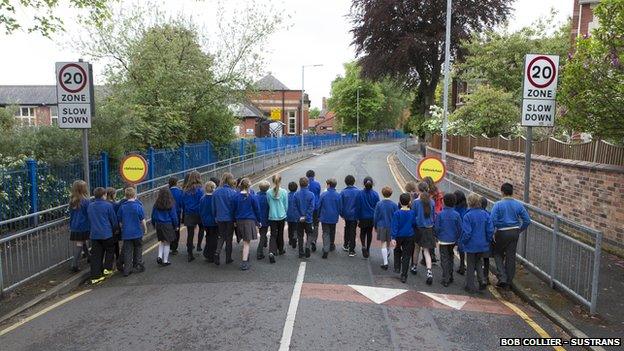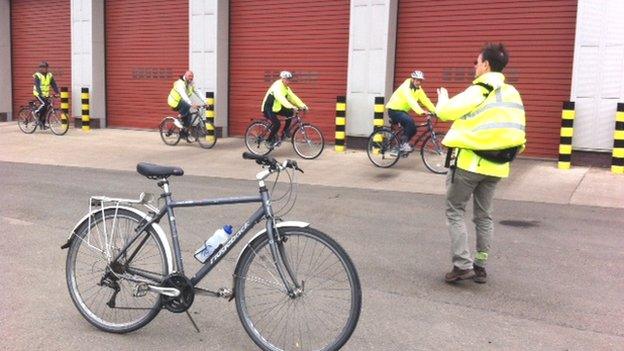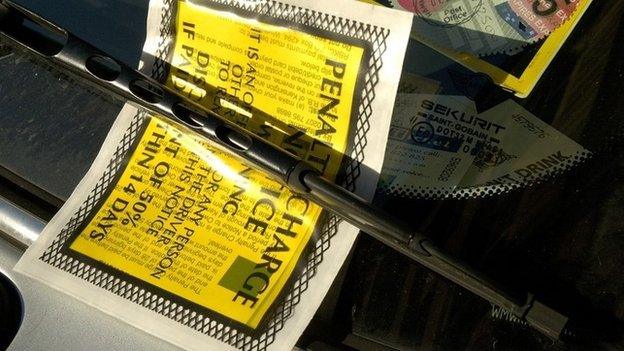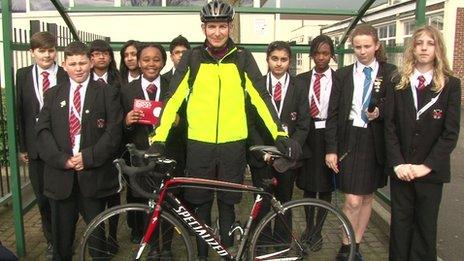Near-miss accidents common on school run say parents
- Published

Sustrans wants a 20mph speed limit across all built-up areas
Over two fifths (41%) of parents in a survey for a transport charity say their child has had a near-miss traffic accident going to or from school.
Road safety is a bigger concern for parents than "stranger danger", suggests the survey for the sustainable transport group, Sustrans.
Some 470 parents of five to 11-year-olds in England, Scotland and Wales were questioned.
Sustrans wants speed limits reduced to 20mph in all built-up areas.
It wants local authorities to ring-fence part of their budget to build dedicated cycling and walking routes to school. And it wants any new housing developments to take into account the needs of walkers and cyclists.
Safer routes
The charity is asking supporters to write to their MPs to urge changes to transport policy to make cycling and walking to school safer.
Sustrans says the most recent government figures on road deaths and injuries show that in 2012, across England, Wales and Scotland, 33 children under the age of 16 died in accidents while walking or cycling and more than 1,800 were seriously injured.
"If a whole classroom of children had been killed under other circumstances there would be public outcry," said Sustrans chief executive Malcolm Shepherd.
"With today's children the least physically active in history and set to have shorter life expectancies than their parents... shuttling kids to the school gate in the car is not the answer.
"Giving children the opportunity to walk, scoot or cycle the school run is vital to their health and well-being, so making our roads safe enough that they can do this must be a top priority," said Mr Shepherd.
Of the parents who took part in the survey, some 18% said their child had experienced a vehicle not stopping or stopping too late at a pedestrian crossing, 13% said their child had nearly been hit by a speeding vehicle while crossing the road and 5% said their child had actually been hit.
Some 44% said road safety was their biggest concern, compared with 28% whose main worry was strangers.
The survey suggested that in a typical week some 61% of children would walk or cycle to or from school at some point, most of them with their parents or another adult.
'Life and death'
A spokesman for the Department for Transport said: "Most drivers know that keeping to the speed limit can mean the difference between life and death in a collision and that they should always remain mindful of pedestrians, especially around schools where children are crossing.
"We want people to drive in a safe manner at all times, which is why we recently increased the fixed penalty to £100 for several driving offences, including careless driving, and why we have given local councils more flexibility so that it is cheaper and easier for them to implement 20mph limits and zones.
"We are also encouraging councils to think about cyclists when designing new road schemes and they can also install safer Puffin crossings to detect when pedestrians have safely crossed."
The Local Government Association said keeping children safe on the school run was of "paramount importance" to councils.
Cllr Peter Box, chairman of the body's Economy and Transport Board said many councils had already introduced 20mph speed limits around schools and were investing in cycling and walking despite funding cuts.
He said many head teachers had asked their councils to introduce CCTV camera cars around their schools to tackle drivers parking on zig-zag lines or pavements, forcing children and parents with buggies to walk in the road.
"Plans by the government to ban the use of CCTV cars in this way will do nothing to solve the real problem of safety outside our schools that this alarming survey clearly highlights and will only leave school children further at risk."
- Published7 May 2014

- Published10 April 2014

- Published27 March 2014

- Published4 November 2013
